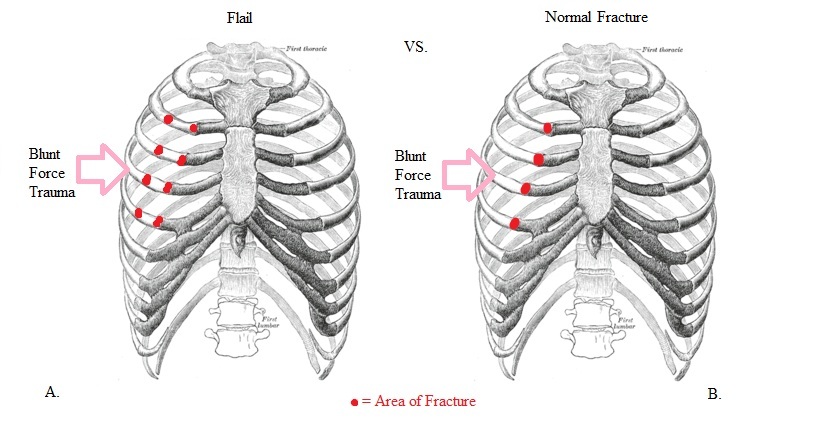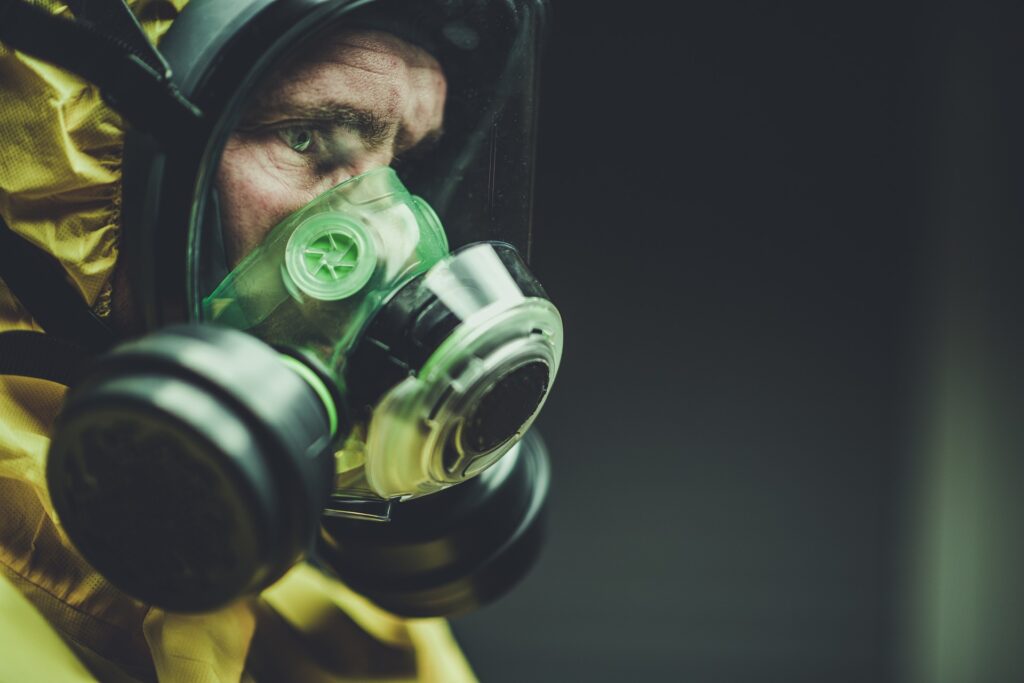Introduction:
Flail chest is a serious condition marked by a segment of the chest wall moving independently due to multiple rib fractures. Let’s know everything:
What is Flail chest?
Flail chest is a thoracic condition resulting from trauma, often occurring when 3 or more ribs sustain fractures in at least 2 places.

Causes of Flail Chest:
- Blunt Trauma: Flail chest most commonly occurs as a result of blunt trauma to the chest, such as from motor vehicle accidents, falls, or physical assaults. The force of impact can lead to multiple fractures of the ribs, causing the chest wall to become detached and move independently.
- High-Velocity Impact: Direct impact to the chest from high-velocity objects or forces, such as during sports injuries or industrial accidents, can also cause flail chest. These incidents exert significant force on the chest, resulting in severe rib fractures and chest wall instability.
- Crush Injuries: Crush injuries involving the chest, such as being trapped between heavy objects or machinery, can lead to flail chest. The compression force applied to the chest can cause multiple rib fractures and segmental instability of the chest wall.
- Falls: Falls from heights or onto hard surfaces can also cause flail chest, especially if the impact is directly on the chest area. The force generated from the fall can result in multiple rib fractures and subsequent detachment of a segment of the chest wall.
- Sports Injuries: Certain high-impact sports, such as football, rugby, or skiing, can predispose individuals to chest trauma and flail chest. Collisions, tackles, or falls during these activities can cause significant chest wall injuries, including multiple rib fractures.
Mechanism of Flail Chest:
The mechanism involves a paradoxical movement of the flail segment during breathing. Instead of expanding with inhalation and contracting with exhalation, the affected chest wall segment moves inversely, impairing normal respiratory mechanics.
Symptoms:
- Severe Chest Pain: Individuals with flail chest often experience intense chest pain, particularly during breathing or coughing. The pain may worsen with movement or palpation of the affected area.
- Visible Chest Wall Deformity: A notable symptom of flail chest is the presence of a visible deformity or abnormal movement of the chest wall. This may include paradoxical movement, where the detached segment of the chest wall moves inward during inspiration and outward during expiration.
- Difficulty Breathing: Flail chest can significantly impair respiratory function, leading to difficulty breathing. Individuals may experience shortness of breath, rapid breathing (tachypnea), or shallow breathing due to the compromised chest wall stability.
- Cyanosis: In severe cases of flail chest, inadequate oxygenation of the blood can lead to cyanosis, a bluish discoloration of the skin and mucous membranes. Cyanosis indicates a lack of oxygen in the bloodstream and requires urgent medical attention.
- Tenderness and Swelling: The chest area affected by flail chest may be tender to the touch and exhibit swelling or bruising. Palpation of the chest wall may elicit pain and discomfort, further exacerbating respiratory distress.
- Coughing and Respiratory Distress: Individuals with flail chest may experience persistent coughing, which can worsen chest pain and respiratory symptoms. Respiratory distress may manifest as increased effort during breathing, audible wheezing, or gasping for air.
- Decreased Lung Expansion: Flail chest can impair lung expansion on the affected side, leading to decreased breath sounds and asymmetrical chest movements during breathing. This decrease in lung function contributes to respiratory compromise and hypoxemia.
Treatment of Flail Chest:
- Pain Management: Managing pain is a critical aspect of flail chest treatment. Analgesic medications, such as nonsteroidal anti-inflammatory drugs (NSAIDs) or opioids, may be prescribed to alleviate chest pain and discomfort. Adequate pain control is essential to facilitate deep breathing and coughing, which are crucial for preventing respiratory complications.
- Respiratory Support: Providing respiratory support is paramount in managing flail chest. Oxygen therapy may be administered to improve oxygenation of the blood and alleviate respiratory distress. In severe cases, mechanical ventilation may be necessary to assist with breathing and ensure adequate ventilation.
- Chest Wall Stabilization: Immobilizing the chest wall is crucial for preventing further movement of the flail segment and promoting healing. Chest binders or supportive devices, such as foam padding or splints, may be applied to stabilize the affected area. These measures help reduce pain and facilitate respiratory mechanics by limiting chest wall paradoxical movement.
- Positive Pressure Ventilation: Positive pressure ventilation techniques, such as continuous positive airway pressure (CPAP) or bilevel positive airway pressure (BiPAP), may be used to improve lung expansion and support respiratory function. These methods help maintain positive pressure in the airways during inspiration and expiration, reducing the work of breathing and enhancing oxygenation.
- Surgical Intervention: In some cases of severe flail chest with associated complications, surgical intervention may be necessary. Surgical procedures, such as open reduction and internal fixation (ORIF) of fractured ribs or thoracotomy, may be performed to stabilize the chest wall and repair damaged tissues. Surgery is typically reserved for cases with significant chest wall instability or respiratory compromise despite conservative management.
- Physiotherapy: Rehabilitation and physiotherapy play a crucial role in the recovery process for individuals with flail chest. Physiotherapists can provide exercises to improve chest wall mobility, strengthen respiratory muscles, and enhance lung function. Early mobilization and breathing exercises help prevent complications such as pneumonia and promote optimal recovery.
Complications:
Complications of Flail Chest
- Pneumonia: Reduced respiratory function and impaired clearance of pulmonary secretions increase the risk of developing pneumonia in individuals with flail chest. Pneumonia can further compromise lung function and prolong recovery, requiring aggressive management with antibiotics and respiratory support.
- Atelectasis: Flail chest can lead to atelectasis, the collapse of a portion of the lung tissue. As the detached segment of the chest wall moves paradoxically during breathing, it can interfere with normal lung expansion and ventilation, contributing to atelectasis. This condition may exacerbate respiratory symptoms and impede oxygenation.
- Pulmonary Contusion: Severe chest trauma associated with flail chest can cause pulmonary contusion, which is bruising or bleeding within the lung tissue. Pulmonary contusion may impair gas exchange and lead to respiratory distress, requiring close monitoring and supportive care to prevent further complications.
- Respiratory Failure: Inadequate chest wall stability and compromised lung function in flail chest can progress to respiratory failure, where the lungs fail to provide sufficient oxygen to the bloodstream or adequately remove carbon dioxide. Respiratory failure is a life-threatening complication that necessitates immediate intervention, including mechanical ventilation and intensive care management.
- Chronic Pain: Some individuals with flail chest may experience chronic pain in the chest area, even after the initial injury has healed. Persistent discomfort may limit physical activity and adversely affect quality of life, requiring long-term pain management strategies and rehabilitation interventions.
- Rib Nonunion or Malunion: In cases where fractured ribs fail to heal properly, nonunion (failure of bone fragments to unite) or malunion (misalignment of healed bone fragments) may occur. Rib nonunion or malunion can lead to persistent chest wall instability, chronic pain, and impaired respiratory function, necessitating surgical correction in some instances.
Summary:
Flail chest poses a significant threat to respiratory function and overall well-being, necessitating swift and appropriate medical attention. Understanding the causes, mechanisms, symptoms, and treatment options for flail chest is imperative for healthcare professionals and the public alike. As research progresses, ongoing efforts to enhance diagnostic methods and treatment modalities will continue to improve outcomes for individuals affected by this challenging condition.
Read Another Article:


Pingback: Home - Common health conditions - ECG Oxford